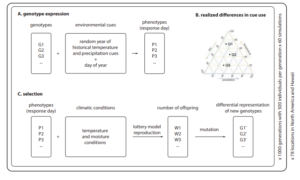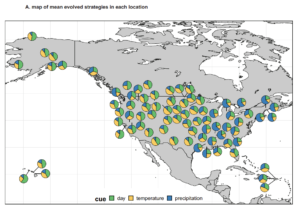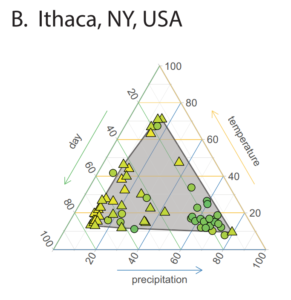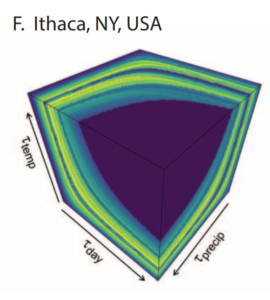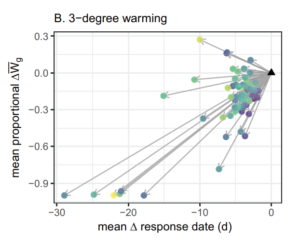(if you’re looking for my current research, it can be found here)
Evolved Phenological Cueing Strategies Show Variable Responses to Climate Change
I’m excited to announce that my first dissertation chapter has just been published in AmNat! In this paper with Louie Yang, we explain how variable responses to climate change can result from evolution to local environmental cues.
Ecologists have documented many species responding to climate change by shifting their phenology (the timing of life history events, like germination, hatching, emergence), and these responses can vary widely, even by species in the same region. To understand this variability, we developed a model linking environmental cues, phenology, and fitness. Key to this model is that organisms integrate multiple environmental cues – in our case: photoperiod, temperature, and precipitation.
With this model in hand we simulated the evolution of thousands of populations, using real daily weather data from 78 weather stations across N. America and Hawaii. We then looked at how the resulting populations responded to simulated climate change. We found that evolved strategies depended in part on geographic region, with populations from nearby locations often evolving similar strategies. Here each pie shows average reliance on the three environmental cues for our simulated populations.
This was a satisfyingly intuitive result: organisms should evolve strategies that predict high fitness, and nearby locations likely share characteristics of their climate. A strategy that works well in one part of Hawaii works fairly well in other parts of Hawaii. But we also sometimes found huge variation in the strategies that evolved in SAME climate regime. The ternary plot below shows the percent cue use of 60 populations (circles and triangles) that evolved in the same climate regime (weather data from Ithaca, NY).
We can see that some of these populations evolved to use dramatically different combinations of cues – those in the bottom right rely almost entirely on precipitation cues, those in the top rely mostly on temperature. Interestingly, many of these differing populations had almost the same fitness (in the climate in which they evolved). The color of the populations above corresponds to their geometric mean fitness. The triangles are all populations within 10% of the most fit strategy.
We discovered this was because in most of our historical climates, there were multiple “solutions” to the problem of how best to integrate cues to optimize phenology. This plot shows fitness in our strategy space – each dimension is (inverse) sensitivity to a cue:
The bright yellow bands (that looks like a section of an onion) shows a broad range of trait combinations that give almost identical fitness. Other work in the paper shows this is because those different strategies result in almost identical behavior in the historic climate.
So we found these two mechanisms that led to the evolution of different cue-integration strategies. The consequences? Populations in different locations — and even in the same location — evolved different strategies, and responded very differently to climate change! Here we see the change in phenology and fitness when populations across our simulations experienced a climate 3 degrees warmer than their historic climate. The black triangle is their starting point – see how variable their responses are!
Strategies that rely heavily on photoperiod don’t respond much to a changing climate, while those that rely on temperature or precipitation can! And unsurprisingly, these variable responses have notable fitness consequences!
There’s more to this story – check out the paper to learn more! (If you don’t have free access to the paper, email/tweet/telegraph me for it)/. This work has been quite a journey (it began with conversations with Louie back in 2015!), and I’m incredibly happy to be able to share the final product with you all!
Simulations to explore a negative relationship between herbivore density and patch size:
Typically, in agroecology, we tend to think of pests doing better in landscapes with large monoculture fields. When a series of field studies found the opposite trend in Andean potato weevils, we were surprised. Using spatially explicit simulations, I explored why herbivores might be more populous in landscapes that have many small fields instead of few large ones. The short answer is that the weevils are dispersal limited, and every year farmers plant their potato field in a different place than the previous year. If the farmers plant fewer, larger fields, the average distance a weevil would have to travel to find potatoes increases, and for even moderately sized fields the weevils are often unable to reach a potato plant. The story is a little more complex than this, and I encourage you to read our recent publication in Theoretical Ecology, “Aggregating fields of annual crops to form larger-scale monocultures can suppress dispersal-limited pests“. This research was done in collaboration with Professor Jay Rosenheim and Dr. Moran Segouli.
Assumption-free approaches to fitting spatial data (using splines):
In ecology we’re often interested in ecological outcomes (like growth and survival, reproduction, or colonization of new habitats) that depend on a number of different factors. Sometimes those factors depend in part on the distance between organisms (growth of a plant can depend on competition, which can in turn depend on distance to competitors; reproduction of a plant can depend on pollination, which can in turn depend on distance to sources of pollinators). Unfortunately, determining the relationship between the strength of an interaction and the distance between organisms can be difficult, particularly with observational data. I worked on a project with Steve Ellner, Peter Adler, Giles Hooker, and Brittany Teller, developing a reliable statistical technique for figuring out how the relative strength of plant competition depended on the distance between plants. We worked out a method for using splines (extremely flexible functions that can take on many shapes) to solve this problem, and used our approach to examine plant competition in a long-term data set of perennial plants in the Idaho Steppe. I gave at talk at the 2015 ESA meeting on our work, and it is now published.

